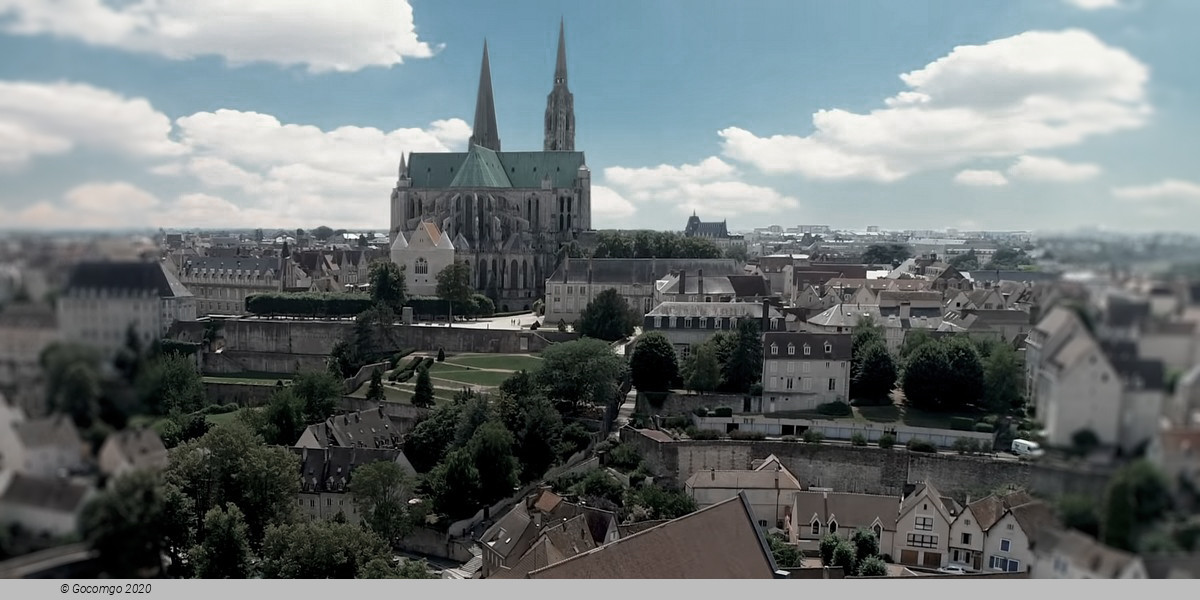Venues in Chartres

Chartres is the prefecture of the Eure-et-Loir department in the Centre-Val de Loire region in France.
Chartres is famous worldwide for its cathedral. Mostly constructed between 1193 and 1250, this Gothic cathedral is in an exceptional state of preservation. The majority of the original stained glass windows survive intact, while the architecture has seen only minor changes since the early 13th century. Part of the old town, including most of the library associated with the School of Chartres, was destroyed by Allied bombs in 1944.
Main sights
Cathedrals and churches
Chartres is best known for its cathedral, the Cathédrale Notre-Dame de Chartres, which is considered one of the finest and best preserved Gothic cathedrals in France and in Europe. Its historical and cultural importance has been recognized by its inclusion on the UNESCO list of World Heritage Sites.
It was built on the site of the former Chartres cathedral of Romanesque architecture, which was destroyed by fire in 1194 (that former cathedral had been built on the ruins of an ancient Celtic temple, later replaced by a Roman temple). Begun in 1205, the construction of Notre-Dame de Chartres was completed 66 years later.
The stained glass windows of the cathedral were financed by guilds of merchants and craftsmen, and by wealthy noblemen, whose names appear at the bottom.
It is not known how the famous and unique blue, bleu de Chartres, of the glass was created, and it has been impossible to replicate it. The French author Michel Pastoureau says that it could also be called bleu de Saint-Denis.
The Église Saint-Pierre de Chartres was the church of the Benedictine Abbaye Saint-Père-en-Vallée, founded in the 7th century by queen Balthild. At time of its construction, the abbey was outside the walls of the city. It contains fine stained glass and, formerly, twelve representations of the apostles in enamel, created about 1547 by Léonard Limosin, which now can be seen in the fine arts museum.
Other noteworthy churches of Chartres are Saint-Aignan (13th, 16th and 17th centuries), and Saint-Martin-au-Val (12th century), inside the Saint-Brice hospital.
Museums
Musée des Beaux-Arts, Fine arts museum, housed in the former episcopal palace adjacent to the cathedral.
Le Centre international du vitrail, a workshop-museum and cultural center devoted to stained glass art, located 50 metres (160 feet) from the cathedral.
Conservatoire du machinisme et des pratiques agricoles, an agricultural museum.
Musée le grenier de l'histoire, history museum specializing in military uniforms and accoutrements, in Lèves, a suburb of Chartres.
Muséum des sciences naturelles et de la préhistoire, Natural science and Prehistory Museum (closed since 2015).
Other sights
The river Eure, which at this point divides into three branches, is crossed by several bridges, some of them ancient, and is fringed in places by remains of the old fortifications, of which the Porte Guillaume (14th century), a gateway flanked by towers, was the most complete specimen, until destroyed by the retreating German army in the night of 15 to 16 August 1944. The steep, narrow streets of the old town contrast with the wide, shady boulevards which encircle it and separate it from the suburbs. The "parc André-Gagnon" or "Clos St. Jean", a pleasant park, lies to the north-west, and squares and open spaces are numerous.
Part of the Hôtel de Ville (City Hall) is a building of the 17th century called Hôtel de Montescot. The Maison Canoniale dating back to the 13th century, and several medieval and Renaissance houses, are of interest.
There is a statue of General Marceau (1769–1796), a native of Chartres and a general during the French Revolution.
La Maison Picassiette, a house decorated inside and out with mosaics of shards of broken china and pottery, is also worth a visit.


